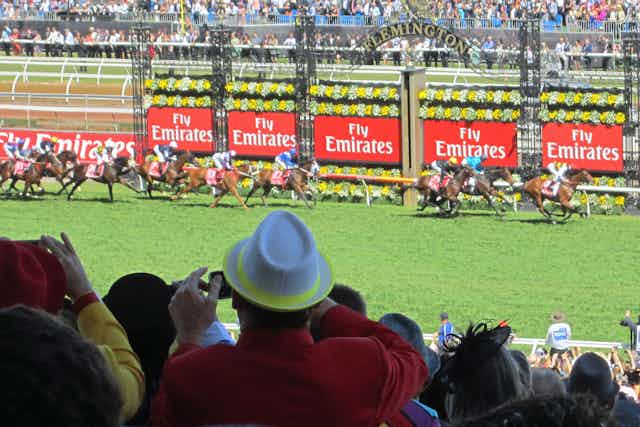The race that stops the nation, the Melbourne Cup, will this year be streamed live on Twitter, competing with the Seven Network’s stream and live TV broadcast of the race.
The Melbourne Cup is not the first sport that Twitter has live streamed, but is the first outside the United States.
Earlier this year the National Football League (NFL) in the United States announced Twitter as “its exclusive partner” to stream certain games to a global audience for the 2016 NFL Regular Season.
The deal worth US$10 million dollars for ten Thursday night games, far less than the US$45 million per game paid by CBS and NBC.
Some of the ten games have already been streamed and referred to by the hashtag #TNF on Twitter.
Reports of the success of the streams have varied, but the numbers are lower than for traditional television broadcasts.
The first stream averaged an audience of 243,000, with each viewer watching 22 minutes of the game on average.
The second game reported to have increased to 327,000. While small compared to 15.4 million average viewing audience for CBS and NFL Network, there is evidence here of future developments in sportscasting, and it’s not only for the major leagues.
Not just for big league sports
During a recent two day sportscasting conference at the AFL’s recently purchased Etihad Stadium in Melbourne, there were a few points that continually came up in the presentations and discussions with those showcasing their products. Those were streaming, grassroots sports, robotic and virtual cameras.
While much of the discussion in the media has been associated with streaming and digital rights of major sporting leagues and events such as AFL, NRL, cricket, Rio Olympics and tennis, there is another area yet to be fully explored. That is, how new video technology and streaming could bring the lower-tier and grassroots sports to fans.
Unlike the major leagues, these sports generally don’t have media rights that include TV broadcasts, nor the big budgets and sponsorship deals.
Streaming to fans
Streaming of games of local clubs and lower-tier sports allows these games to be delivered to an audience, without the need of traditional TV broadcast. The streams could be delivered to the club or leagues website or direct to social media platforms, which have recently becoming heavily involved in live video.
The streaming of live sport will be one of the pillars that community television station C31 will focus on as it faces the loss of its TV broadcast transmission at the end of this year.
Echo Sports Network (ESN) and Sportcast Australia are two other organisations assisting local clubs and leagues to stream their games.
The streaming of local sports allows these games to be delivered not only to a local audience, but also to a global audience. These streams also assist with filling the void of the lack of local sport content on regional television stations across the country.
But there is still a cost in having the required number of cameras and operators at a game, with some sports requiring more than others. This is an area that is also changing due to technological developments, and could allow further expansion of sportscasting in the future.
Robotic cameras
At the sportscasting conference Hawk-Eye Innovations discussed its development in the use of robotic cameras for sports broadcasts.
Hawk-Eye in Australia is commonly known in association with tennis and cricket. But it’s less known SMART Production product could allow for more sports to be broadcast or streamed.
This technology has been used at both Wimbeldon and the Australian Open for greater broadcast coverage of outer court play.
Solo Shot is another robotic camera solution that could be used by individuals due to its tracking solution. There are also now a number of drones that can track individuals and could bring some interesting perspectives to sports coverage in the future.
Virtual cameras
In addition to robotic cameras, the advancements in virtual cameras could change the future approaches of sportscasting, particularly its ability to reduce the number of staff required to cover a game.
One example is Pixellot’s products, which uses multiple cameras with the multiple images then stitched together as one image. An operator can then select spaces to view on the stitched image.
This allows for the cutting between cameras as seen in a traditional sports broadcast. In addition, the moving between angles can be undertaken by the viewer themselves.
Livestream has also recently announced another smaller virtual camera solution, Mevo. This could be a lower cost solution used for sporting events played within a smaller location.
A big benefit of Mevo is that it can also live stream directly to Facebook Live, with an iOS device being used for switching between virtual cameras and setting up face tracking.
More sportscasting to come
With the wide range of technology that is being released, the future of sportscasting could be a prosperous one, particularly for grassroots and lower-tier sports.
As the penetration rate of internet-connected television continues in Australia - currently at 36% (compared to 30% the previous year) - this will further allow these sports to enter Australian lounge rooms.
So with greater access to more sports, will the traditional TV audience continue to decline?
Last year the Seven Network reported a decline in TV audience for the Melbourne Cup, but was excited to have had more than 300,000 viewing the stream.
For this year’s event, the Victoria Racing Club (VRC) says Twitter will live stream the Melbourne Cup from 2.30PM AEDT in its entirety, free of charge, on any Twitter and connected devices. Keep a watch on @FlemingtonVRC for any updates.
It will be interesting to see how many people tune in to the streams being provided by Twitter and the Seven Network compared with the TV broadcast.

